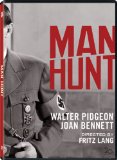Shortly before World War II, British officer Alan Thorndike (Walter Pidgeon), vacationing in Bavaria, puts his sterling hunting skills to use by framing Adolf Hitler in his gun sights. He pulls the trigger on an empty barrel, not really planning to perform an assassination. Then, after a moment’s hesitation, he loads the gun, but is captured before anything history-changing occurs. The Gestapo leader Major Quive-Smith (George Sanders) wants him to confess to being an assassin working for the British government. Thondike refuses. He manages to escape, and Quive-Smith’s forces (including the always sinister John Carradine) pursue Thorndike to England, where he falls in with innocent Cockney lass Jerry (Joan Bennett).
Man Hunt (1941) was one of Fritz Lang’s first American films. It has many strengths, but it is also not one of his masterpieces, certainly not in the same league as M or the Dr. Mabuse films. For one thing, it has the usual bizarre Hollywood casting that has Canadian Pidgeon as an English aristocrat, New Jerseyite Bennett with a painful Cockney accent, and the English Sanders as a German (though, to be fair, much is made of the fact that his character comes across as more English than English). As well, the slow-blooming romance between Pidgeon and Bennett simply isn’t that interesting, and serves primarily to slow the film down, and force us to wait impatiently for the manhunt to resume. Said hunt is rather broken up, and the wonderful Most Dangerous Game-style idea of Thorndike using his skills as a hunter to survive is barely used. However, the suspense scenes are expertly handled, with dramatic lighting and impeccable camerawork creating a palpable sense of paranoia. So the strengths are mighty ones indeed.
Video
The film has been subject to an excellent restoration process. The image is sharp, and almost completely free of grain. There almost no visible damage or speckling, and the black-and-white tones are superb, beautifully capturing every nuance of the lighting. There are some minor halos visible over the character heads in some instances, but they aren’t bad enough to be troublesome.
Audio
Two options here: the original mono and a stereo mix. The stereo has some slight surround presence, and that includes dialogue that should not be coming out of the rear speakers, though the sound is faint enough that one has to listen closely to be aware of it. Otherwise, there is a nice richness to the mix, and there is essentially no distortion.
Commentary Track: Author Patrick McGilligan’s commentary is articulate and packed with background information, not just on Lang and the leads, but also the likes of the production designer. Another solid film-course-in-a-box from Fox.
Special Features
“Rogue Male: The Making of Man Hunt: (16:42) An informative featurette, situating the film in its historical and political context as well as clarifying its position in Lang’s career. McGilligan is back with some remarks here, and is joined by Kim Newman among other notable scholars.
Theatrical Trailer.
Restoration Comparison.
Advertising, Artwork and Still Galleries.
Final Thoughts
A nice bit of WWII suspense and propaganda, coming out not too long before America would join in the fray. Not the pinnacle of Fritz Lang’s career, but it does boast some very striking sequences, and is well worth catching.





